Genre: Fighting Developer: System Vision Publisher: Takara Players: 1-2 Released: 1994
I once again find myself reviewing another clone game, only this time the situation is much more dire. Samurai Showdown (referred to hereafter as SS), is a 2D versus fighter from the early nineties, and therefore will probably never escape comparisons to the eternal king of fighters that is Street Fighter II. Go look around at other reviews, and you’ll see a slew of such things as “almost as good as SFII,” “a clone that shows its inspiration a thing or two,” “this game is a pretty darn good Street Fighter clone,” and so on. So is SS a clone? Certainly. Are comparisons to Street Fighter legitimate? Of course. Despite that, is it worthy of being judged as a game instead of being balanced against its inspiration?
Yes.
You’ve probably figured out what type of game SS is. You play as one of about a dozen different characters and bash it out against either the computer or a human opponent in a best-out-of-three, kill-or-be-killed, fight-to-the-death, showdown-of-the-ages confrontation. So, yeah… it’s a SFII-type game. But unlike other games of the era like Sega’s own Eternal Champions and even SNK’s Fatal Fury series, SS makes a genuine effort at bringing a spark of life to a tired genre. Not only that, but it does so in a legitimate, simple, non-gimmicky way.
It adds swords, and therefore instantly puts itself on the map as something different. And it doesn’t just add in a token slash or two instead of a punch. SS makes swordplay the central part of the game. You can lock blades with your opponent, at which point the fastest finger will flick away the enemy’s weapon. When you lose your sword you must fight with your hands and feet until you pick it up again. Believe me when I say that’s bad. You don’t want to block a razor-sharp edge with your fists. In the meantime, with a little timing you can catch your foe’s blade in between your palms and throw them around.
Seriously, how many games back in circa 1993 had that sort of detail? Which leads me to one of the most attractive things about SS: class. This isn’t some cheap little rip-off piece of junk that just barely scrapes by. SS has all sorts of marvelous bells and whistles that kept me smiling at the pure showmanship of it all. When particularly impressive blows are given, the game goes into slow motion and allows you to relish the moment. In every background there’s something to break up or smash apart, and if you can do it while pummeling your pansy competitor to death, then so much the better. There’s also something of a fatality-esque ending sequence that can occur (how you trigger it I haven’t yet figured out yet): the opponent’s weapon goes arcing off and a geyser of blood erupts from their neck before they topple over in a heap.
To say that SS has a clichéd cast would be just plain wrong. SS carries on with the innovation motif even in the roster. There’s the bizarre little wild card freak Gen-An, for instance, who packs a wallop despite his small size; Ukyo, the Vega-like silent samurai; and Tam-Tam, the crazy Mayan avenger. Each fighter has a wonderfully unique feel and a distinct personality, and it’s obvious that a different playing style is required for each one (something that other SFII clones often lack). Each has smart-aleck little one-liners and wacky boasts that really liven things up, and the game isn’t afraid to admit that it’s a game: the grizzled government agent Jubei reminds you that “No, I’m not related to that guy from Fatal Fury” A nice touch, especially considering that was the first thing I thought when I saw him.
Another thing I particularly appreciate about SS is the nice, simple move list. Most of the characters have only 2-5 special moves – a welcome change after the dizzying Eternal Champions array (Shadow is just insane, by the way). The simplicity makes learning how to play with a new character anything but a chore, and after only an hour or two of fighting I was comfortable fighting with five of the contestants. A short move list, though, doesn’t mean that the combat is shallow. It’s quite the opposite, actually. Fighting, at least on lower levels of difficulty, went at a slow enough pace that I was able to actually use a bit of strategy and use special moves logically. Another welcome change from the button-mashing fests of other fighters.
Doing special moves over and over again will get you nowhere fast. That’s right, gone are the days of ten-minute long Hadoken assaults. The AI in this game is smart to begin with, and it learns to boot. Use a special too much and the computer will start taking advantage of you (try throwing a bunch of Haohmaru cyclones against Hanzo. You’ll see just how fast the computer can get a perfect). So overall the computer is a worthy opponent, to say the least, and I think you’ll find that, with judicious use of the difficulty setting, you’ll always be able to have a lively match.
As far as graphics and animation are concerned, I would say they’re above average. Everything’s delightfully colorful and cartoonish, and the backgrounds are equally enjoyable. Animation is usually smooth (more on that later), and you never lose characters in the backgrounds. SNK did a good job with the graphics here; my only gripe is the flickery shadows. They’re very distracting.
Now, about the animation. SS is, for the most part, smooth. There are specific things that cause slowdown, and when that happens it’s incredibly frustrating. Two of the characters use animals for some special moves. Although that’s really cool, the added sprite slows things down. And if both of the combatants have animals, then the slowdown is even worse. Also, if you turn up items on the menu, then you’ll have even more slowdown. I’m guessing that the SS engine was using pretty much all the power of the Genny if a few coins, health items, and critters affect the performance like this. For best results, turn off the items and use one of the critter-less characters. It’ll run nice and smooth then (heaven help you if you end up in a Galford vs. Nakoruru fight with maximum items).
Sound, you ask? Genny fighters have notoriously bad voice samples (Eternal Champions), but SS doesn’t really bug me much. Why? Quite simply because everything’s in Japanese and therefore I can’t tell what they’re saying anyway. That’s right – all of the voice clips except for Galford and Charlotte (Hey! She said a naughty word!) are in Japanese. So don’t worry about it. The normal sound is adequate. Nothing blew me away, but sound effects rarely do.
As for the music, well I’ll admit it: I love Genesis music! That said, though, I’d have to rate the SS tracks as merely “appropriate.” They’re refreshingly subdued for a fighter (very Zen-like, if you ask me), and contrast nicely to the carnage raging onscreen. All are very Japanese, and all are very forgettable.
Is there anything else to cover? I guess I’d like to return once again to the sheer class and presentation of SS. From the opening title screen with the pink blossoms floating down past a red “Takara” to the post-battle quotes from the fighters, SS is a game that was flawlessly presented. Hats off to SNK for their design and hats off to Takara for finally doing a conversion of one of SNK’s classics that does justice to the original. Samurai Showdown has earned itself a place in my library, and it definitely should in yours, too. Maybe fighter connoisseurs with a picky streak will find fault with it, but to me this game is a true gem and possibly even eclipses the lofty Street Fighter II.
A Samurai fears nothing, struggles to triumph over evil, and lives for one purpose: to destroy all enemies. It’s showdown time!
SCORE: 9 out of 10

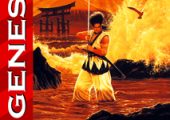
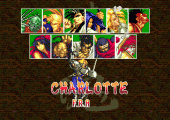
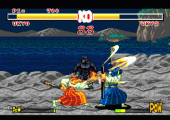
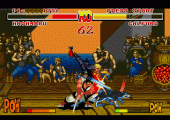
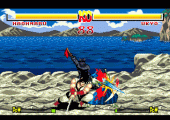
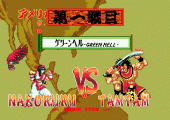
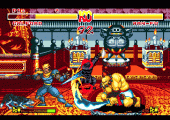
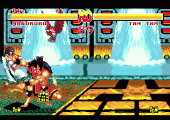
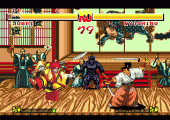
Recent Comments